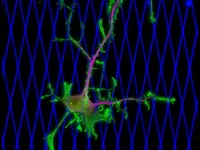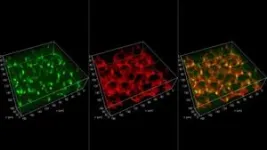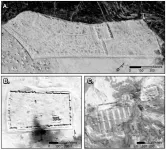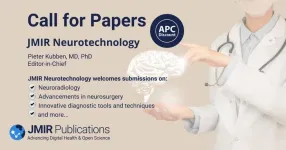(Press-News.org) UNIVERSITY PARK, Pa. — The most lethal feature of any cancer is metastasis, the spread of cancer cells throughout the body. New research led by Penn State reveals for the first time the mechanics behind how breast cancer cells may invade healthy tissues. The discovery, showing that a motor protein called dynein powers the movement of cancer cells in soft tissue models, offers new clinical targets against metastasis and has the potential to fundamentally change how cancer is treated.
“This discovery marks a paradigm shift in many ways,” said Erdem Tabdanov, assistant professor of pharmacology at Penn State and a lead co-corresponding author on the study, recently published in the journal Advanced Science. “Until now, dynein has never been caught in the business of providing the mechanical force for cancer cell motility, which is their ability to move themselves. Now we can see that if you target dynein, you could effectively stop motility of those cells and, therefore, stop metastatic dissemination.”
The project began as a collaboration between Penn State’s Department of Chemical Engineering and Penn State’s College of Medicine, before growing into a multi-institution partnership with researchers at the University of Rochester Medical Center, Georgia Institute of Technology, Emory University, and the U.S. Food and Drug Administration.
The researchers used live microscopy to watch the migration of live breast cancer cells in two different systems modeled after the human body. The first system, a two-dimensional network of collagen fibers, revealed how cancer cells move through an extra cellular matrix that surrounds tumors and showed that dynein was key to the movement of cancer cells. The second system was a three-dimensional model developed by a team led by Amir Sheikhi, Dorothy Foehr Huck and J. Lloyd Huck Early Career Chair in Biomaterials and Regenerative Engineering and assistant professor of chemical engineering and biomedical engineering at Penn State.
The second system was designed to mimic soft tissue using a network of microscopic hydrogel particles or microgels linked together in tumor-like shapes. Like in the two-dimensional model, the researchers found in the three-dimensional model that dynein was “indispensable” in the spread or metastasis of cancer cells.
“Using these three-dimensional models that partially mimic a tumor, we discovered that if we block the dynein, the cancer cells cannot effectively move and infiltrate solid tissues,” Sheikhi said. “In both models, we found that dynein is extremely important for cell locomotion, which suggests a whole new method for cancer management. Instead of killing the cancer cells with radiation or chemotherapy, we are showing how to paralyze them. This is great news because you don't really have to kill the cells, which is a harsh approach that targets both cancerous and healthy cells. Instead, you just have to stop the cancer cells from moving.”
Tabdanov explained that cell “paralysis” could prove to be an effective treatment strategy for cancer compared to chemotherapeutic treatments, because after surgical removal of the main tumor, it could prevent the cancer from spreading without damaging healthy tissues and cells.
“The trick with chemotherapy is to kill the cancer cells slightly faster than the rest of the body — it’s a race against time,” Tabdanov said. “Chemotherapy causes a lot of damage to the body’s normal, healthy tissues while it is busy killing the cancer. If we instead contained the cancer, stopped it in its tracks, we could keep the healthy parts of the body healthy.”
The researchers noted that any potential clinical treatment is still far off — as they have yet to run human or animal trials. Sheikhi has filed multiple patents related to his team’s platform and plans to use the technology to study a myriad of diseases, including other cancers.
“We are very excited about this collaboration with the Penn State College of Medicine, and our labs are working closely on other projects,” Sheikhi said. “I think these platforms could one day enable personalized medicine and personalized treatment for cancer and, hopefully, many other diseases.”
Other authors on the paper are Yerbol Tagay of Penn State College of Medicine; Sina Kheirabadi and Zaman Ataie of Penn State’s Department of Chemical Engineering; Rakesh Singh of the University of Rochester Medical Center; Denis Tsygankov of Georgia Institute of Technology and Emory University; and Olivia Prince, Ashley Nguyen, Alexander Zhovmer and Xuefei Ma of the U.S. Food and Drug Administration.
Startup funds from the Department of Pharmacology at Penn State College of Medicine, the Meghan Rose Bradley Foundation, the National Science Foundation, the National Institutes of Health, and the U.S. Food and Drug Administration supported this work.
END
Mechanics of breast cancer metastasis discovered, offering target for treatment
2023-10-27
ELSE PRESS RELEASES FROM THIS DATE:
Cold War spy satellite imagery reveals Ancient Roman forts
2023-10-27
Two-thousand years ago, forts were constructed by the Roman Empire across the northern Fertile Crescent, spanning from what is now western Syria to northwestern Iraq.
In the 1920s, 116 forts were documented in the region by Father Antoine Poidebard, who conducted one of the world's first aerial surveys using a WWI-era biplane. Poidebard reported that the forts were constructed from north to south to establish an eastern boundary of the Roman Empire.
A new Dartmouth study analyzing declassified Cold War satellite ...
Call for Papers: JMIR Neurotechnology
2023-10-27
JMIR Neurotechnology, published by JMIR Publications, welcomes submissions from researchers, clinicians, caregivers, and technologists that explore novel diagnostic and treatment tools for neurological disorders, particularly those leveraging the potential of neurotechnology.
The scope of the journal includes but is not limited to:
Neuroradiology
Advancements in neurosurgery
Innovative diagnostic tools and techniques
Cutting-edge neurotechnology for therapeutics
Data sharing and open science in neurotechnology
Code ...
fMRI study finds correlated shifts in brain connectivity associated with overthinking in adolescents
2023-10-27
COLUMBUS, Ohio – A new study from The Ohio State University Wexner Medical Center and College of Medicine, University of Utah and University of Exeter (UK) substantiates previous groundbreaking research that rumination (overthinking) can be reduced through an intervention called Rumination-focused Cognitive Behavioral Therapy (RF-CBT). In addition, the use of fMRI technology allowed researchers to observe correlated shifts in the brain connectivity associated with overthinking.
Study findings are published online in the journal Biological Psychiatry Global Open Science.
“We know adolescent ...
Meltwater flowing beneath Antarctic glaciers may be accelerating their retreat
2023-10-27
A new Antarctic ice sheet modeling study from scientists at UC San Diego’s Scripps Institution of Oceanography suggests that meltwater flowing out to sea from beneath Antarctic glaciers is making them lose ice faster.
The model’s simulations suggest this effect is large enough to make a meaningful contribution to global sea-level rise under high greenhouse gas emissions scenarios.
The extra ice loss caused by this meltwater flowing out to sea from beneath Antarctic glaciers is not currently accounted for in the models generating major sea-level ...
Underwater robot finds new circulation pattern in Antarctic ice shelf
2023-10-27
ITHACA, N.Y. – More than merely cracks in the ice, crevasses play an important role in circulating seawater beneath Antarctic ice shelves, potentially influencing their stability, finds Cornell University-led research based on a first-of-its-kind exploration by an underwater robot.
The remotely operated Icefin robot’s climb up and down a crevasse in the base of the Ross Ice Shelf produced the first 3D measurements of ocean conditions near where it meets the coastline, a critical juncture known as the grounding zone.
The robotic survey revealed a new circulation pattern – a jet funneling water sideways through the crevasse – in addition to rising and sinking currents, ...
Like humans, baboons are strategic cooperators
2023-10-27
A team led by CNRS scientists1 has discovered that, just like humans, Guinea baboons develop complex strategies to select partners for cooperation, basing their decisions on past interactions. Humans naturally engage in strategic cooperation in many contexts. For example, when children help schoolmates by lending them their class notes, they may expect the same in return the next time: this is known as reciprocity. But if the favour is not returned, they are likely to seek others with whom to cooperate.
The team’s findings ...
Hidden way for us to feel touch uncovered by Imperial researchers
2023-10-27
Imperial researchers have discovered a hidden mechanism within hair follicles that allow us to feel touch.
Previously, touch was thought to be detected only by nerve endings present within the skin and surrounding hair follicles. This new research from Imperial College London has found that that cells within hair follicles – the structures that surround the hair fibre – are also able to detect the sensation in cell cultures.
The researchers also found that these hair follicle cells release the neurotransmitters histamine and serotonin in response to touch – findings that ...
Study: Metformin can help youth manage weight gain side effect of bipolar medications
2023-10-27
A new large-scale study led by researchers at the University of Cincinnati and Northwell Health, New York's largest health care provider, found the drug metformin can help prevent or reduce weight gain in youth taking medication to treat bipolar disorder.
The collaborative team presented its findings during a symposium at the American Academy of Child and Adolescent Psychiatry conference in New York City Oct. 27.
Weight gain side effect
Medications to treat bipolar disorder, known as second-generation antipsychotics (SGAs), are often effective at helping young ...
AI can alert urban planners and policymakers to cities’ decay
2023-10-27
By April Toler
More than two-thirds of the world’s population is expected to live in cities by 2050, according to the United Nations. As urbanization advances around the globe, researchers at the University of Notre Dame and Stanford University said the quality of the urban physical environment will become increasingly critical to human well-being and to sustainable development initiatives.
However, measuring and tracking the quality of an urban environment, its evolution and its spatial disparities is difficult due to the amount of on-the-ground data needed to capture these patterns. To address the issue, Yong Suk Lee, assistant professor of technology, ...
NASA rocket to see sizzling edge of star-forming supernova
2023-10-27
A new sounding rocket mission is headed to space to understand how explosive stellar deaths lay the groundwork for new star systems. The Integral Field Ultraviolet Spectroscopic Experiment, or INFUSE, sounding rocket mission, will launch from the White Sands Missile Range in New Mexico on Oct. 29, 2023, at 9:35 p.m. MDT.
For a few months each year, the constellation Cygnus (Latin for “swan”) swoops through the northern hemisphere’s night sky. Just above its wing is a favorite target ...







